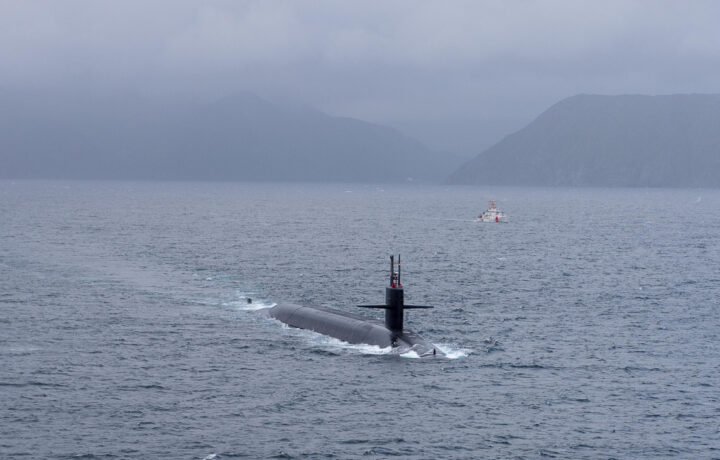Recently, the United States Navy’s USS Kentucky (SSBN-737) became the first nuclear-armed ballistic missile submarine to make a port call in South Korea in more than 40 years. The Ohio-class submarine arrived in the port city of Busan just days after North Korea test-fired a solid-fueled intercontinental ballistic missile (ICBM), which reportedly flew for more than an hour before landing short of Japanese waters.
That launch received condemnation from Western leaders, and it was the 15th of the year to be conducted by Pyongyang. ICBMs are seen as a concern due to their long-range and they have the potential to hit the mainland United States.
However, the visit had already been planned as part of the April 26 “Washington Declaration” to mark the 70th anniversary of the United States-Republic of Korea (ROK) Alliance.
“Going forward, the United States will further enhance the regular visibility of strategic assets to the Korean Peninsula, as evidenced by the upcoming visit of a U.S. nuclear ballistic missile submarine to the ROK, and will expand and deepen coordination between our militaries,” the White House announced in April.
According to the South Korean Ministry of National Defense, the last time a U.S. ballistic nuclear submarine made a visit to the nation was in the early 1980s.
“The deployment of U.S. nuclear-powered ballistic missile submarines (SSBNs) on the Korean Peninsula is an example of action demonstrating that the US extended deterrence against the Republic of Korea will be firmly implemented,” Minister of National Defense Lee Jong-seop said via a statement. “We are demonstrating a solid ROK-US combined defense posture to the people and the international community.”
Seoul’s National Security Adviser, Kim Tae-hyo also said this week that the U.S. had “demonstrated strong resolve that in case the north attacks the south with nuclear weapons, it will be met with immediate, overwhelming and decisive counter-measures, leading to the demise of its regime.”
More Visits to Come?
As part of the Washington Declaration, the White House signaled that it would make its defense commitments more visible – and that could include not only nuclear-armed submarines but other strategic assets including nuclear-capable bombers.
During the 1970s, such deployments of nuclear-armed submarines to South Korea had been common, but the visits became less frequent at the tail end of the Cold War, when the threat from North Korea to the south declined. The last visit took place in 1981.
Though USS Kentucky was the first ballistic missile submarine to make a visit to South Korea in more than four decades, the Ohio-class guided-missile submarine USS Michigan (SSGN-727) also made a port call to Busan just last month. However, USS Michigan is one of the four Ohio-class submarines that were modified to serve as cruise missile boats.
Show of Force
The arrival of the submarine has been seen as purely symbolic, and some military experts have even suggested the boat’s presence in port in South Korea would reduce its military value. Experts have noted that the range of the ballistic means they don’t need to be anywhere close to the peninsula.
“Tactically, (the U.S. and South Korea) are diminishing the sub’s most powerful asset; its stealthiness,” Carl Schuster, former director of operations at the U.S. Pacific Command’s Joint Intelligence Center in Hawaii, told CNN in April, who added, “If Kim Jong Un was looking to do a surprise strike, we’ve given him the submarine’s location and time it will be there.”
One of the Boomers
The unmodified Ohio-class subs are colloquially known as “bombers,” and each can carry a maximum of 20 Trident II ballistic missiles, each of which can deliver up to eight nuclear warheads to targets as far as 12,000km (7,500 miles) away.
USS Kentucky was the 12th Ohio-class submarine to be laid down. Commissioned in 1991, it is now one of 14 U.S. Navy submarines capable of carrying ballistic missiles. Originally assigned to Naval Submarine Base Kings Bay, Georgia, SSGN-737 shifted her homeport to Naval Submarine Base Bangor, Washington, in November 2002.
According to the Navy, the boat was honored by U.S. Strategic Command (STRATCOM) in 2009 as the recipient of the Omaha Trophy for excellence in strategic deterrence, while she also received the Battle Efficiency Award (Battle “E”) for Submarine Squadron (SUBRON) 17. In April 2015, USS Kentucky completed a 39-month engineered refueling overhaul at Puget Sound Naval Shipyard and Intermediate Maintenance Facility, successfully finishing sea trials on April 16, 2015.
Each of the Ohio-class submarines has nearly unlimited range and has a complement consisting of 15 officers and 140 enlisted sailors.




